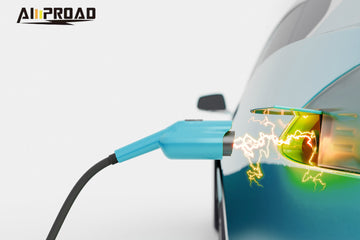
As more car owners transition to electric vehicles (EVs), understanding how to charge these vehicles becomes increasingly important. Unlike gasoline cars, which can refuel quickly at any gas station, EVs have different charging options depending on the urgency and convenience required. Charging an EV can be broadly categorized into fast charging and slow charging, each suited to different scenarios. Let's explore the various ways to charge an electric vehicle, the types of chargers available, and practical tips for maximizing efficiency.
There are three commonly used types of charging equipment for electric vehicles: portable charging boxes, AC EV chargers (including Level 2 EV chargers), and DC EV chargers. Each type has distinct advantages and uses. A portable charging box is a convenient and versatile solution that can be used almost anywhere with a standard electrical outlet. Most EV manufacturers include a portable charging box as standard equipment. These devices usually feature a 16A plug (similar to those used by household air conditioners) but can also come with a 10A plug. They allow you to charge your EV from any regular 220V socket. The advantages of portable charging boxes include portability, ease of use, and no additional installation required. However, they are limited by slow charging speeds, with power ratings of 220V16A or 220V10A providing only 2-3 kWh per hour. Charging a vehicle with a range of 400-500 kilometers can take over a day to fully charge from empty using a portable charging box.
AC EV chargers, also known as Level 2 EV chargers, offer faster charging speeds and are ideal for home use. They typically require a dedicated installation, either wall-mounted or floor-mounted. The most common version is the single-phase 7kW charger, which is compatible with the vehicle's onboard charger that converts AC power to DC for the battery. These chargers offer a moderate charging speed, with a 7kW Level 2 EVCS charging station capable of fully charging a car with a 400-500 km range overnight, making it perfect for daily use. The convenience of having a Level 2 EV charger installed at home provides a reliable and consistent charging solution. However, professional installation is required, and an upgrade to your home's electrical system may be necessary.
DC EV chargers, on the other hand, are the most powerful and fastest charging option, commonly found at public charging stations. They convert three-phase AC power directly into DC, which is then fed into the vehicle's battery. These chargers can have power ratings from tens of kW to over 100 kW, significantly reducing charging time. DC EV chargers offer the fastest charging speed, capable of adding over 200 kilometers of range in just 30 minutes, making them ideal for long trips or urgent situations. They are widely available at commercial charging stations along highways and in urban areas. However, they require robust electrical infrastructure, making them less practical for home use, and they are generally more expensive to use due to their high power output.
When it comes to charging scenarios, fast charging and slow charging serve different purposes. Fast charging is ideal for situations where time is a constraint. DC EV chargers provide rapid charging, suitable for long trips or when you need to quickly top up your battery. Slow charging, on the other hand, is suitable for daily commuting and regular use. Level 2 EV chargers, often installed at home, provide a slower but steady charge, typically completed overnight.
For those who prefer the convenience of charging anywhere, portable charging boxes are indispensable. Simply plug into any 220V socket, and you're set. However, remember that this method is best for emergency use due to its slow speed. Installing a Level 2 EV charger at home is a smart move for regular charging needs. It's essential to have a professional handle the installation to ensure it meets electrical codes and safety standards. The fastest home EV charger, such as those from EV charger manufacturer AMPROAD, can provide up to 7kW of power, making them efficient for overnight charging.
While installing a DC EV charger at home is generally impractical due to its power demands, understanding their use at public stations is crucial. When planning long trips, map out the locations of DC chargers along your route. Tesla destination chargers, often found at hotels and restaurants, provide a convenient solution for Tesla owners needing a quick recharge during stops.
To get the most out of your EV charging experience, consider the following tips: Plan your charging stops by using apps and maps to locate charging stations along your route. Knowing where Tesla destination chargers and other public chargers are can save you time and reduce range anxiety. For daily use, a Level 2 EV charger offers the best balance of speed and convenience. Brands like AMPROAD offer some of the fastest home EV chargers, ensuring you start each day with a full battery. While fast charging is convenient, it's advisable to use DC fast chargers only when necessary, as regular use can degrade the battery over time. Additionally, optimize your charging times by charging during off-peak hours when electricity rates are lower. This can save money and reduce strain on the power grid.
The future of EV charging looks promising, with advancements aimed at making charging faster, more accessible, and more efficient. New technologies are being developed to reduce charging times even further, with some upcoming models promising to add 100 kilometers of range in just a few minutes. Innovative solutions like wireless charging, which allows EVs to charge without plugging in by simply parking over a wireless charging pad, are also on the horizon. Some companies are exploring the idea of battery swapping stations, where you can replace your depleted battery with a fully charged one in a matter of minutes.
All in all, charging an electric vehicle involves understanding the different types of chargers and their appropriate use cases. Portable charging boxes provide a handy solution for emergencies, while Level 2 EV chargers are ideal for daily home use. For rapid charging needs, DC EV chargers at public stations are indispensable. By choosing the right equipment and adopting smart charging habits, you can ensure your EV is always ready to go. Companies like EV charger manufacturer AMPROAD offer a range of options to suit different needs, making the transition to electric driving smoother and more convenient. As technology continues to evolve, the future of EV charging promises even greater advancements, making electric vehicle ownership more practical and enjoyable than ever before.


